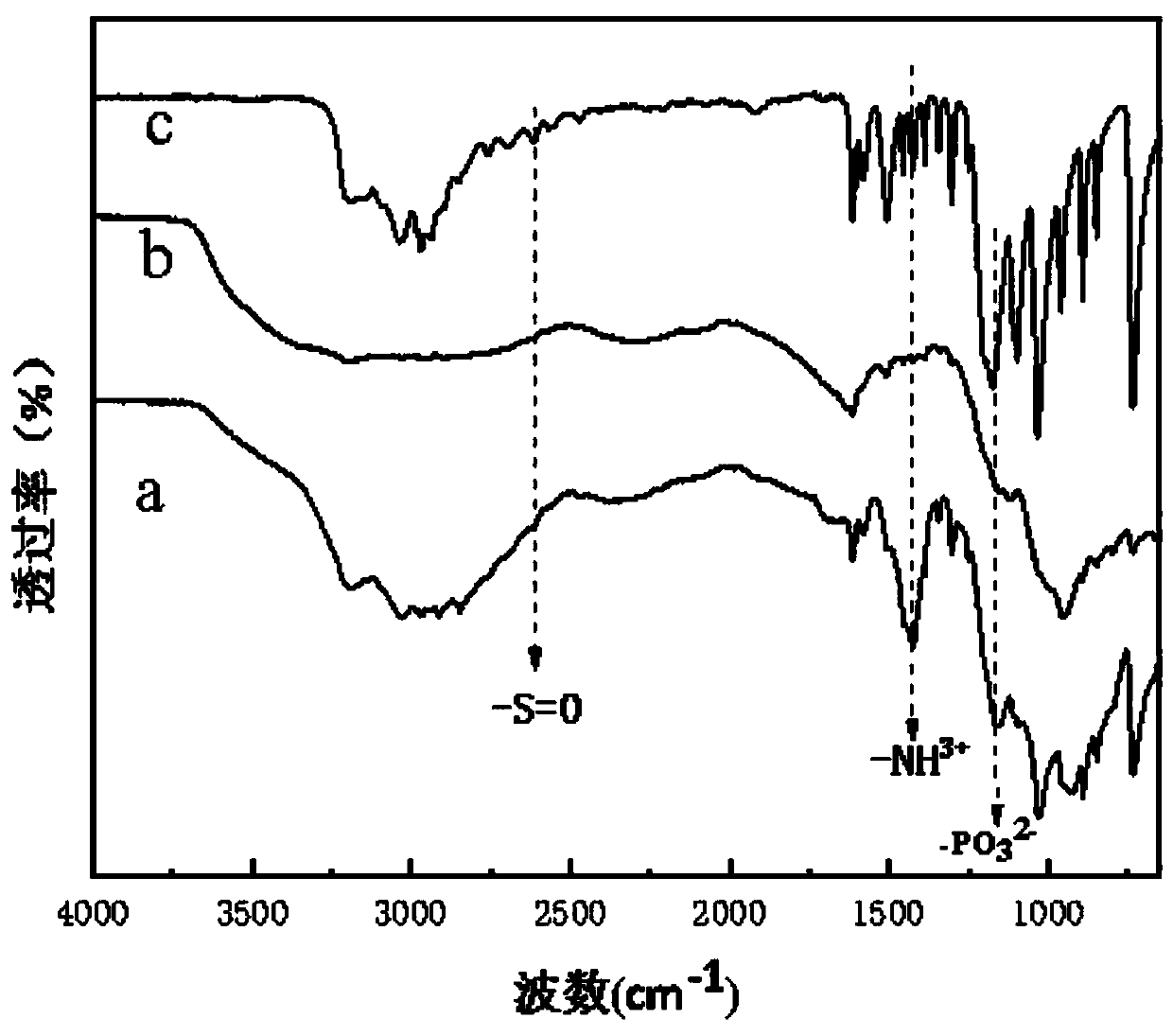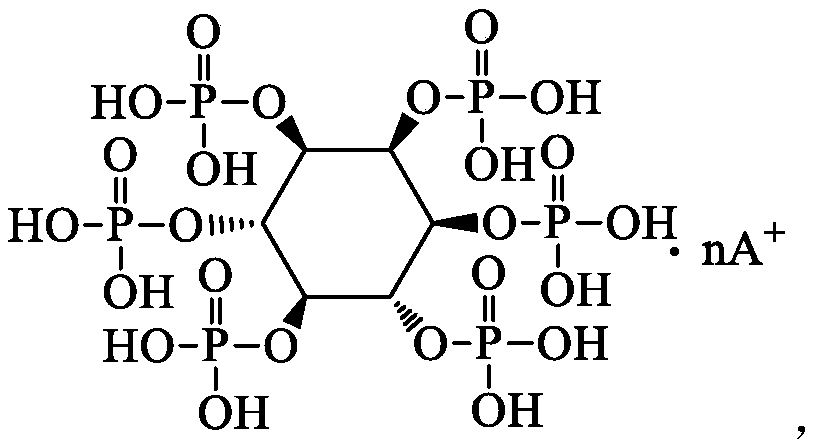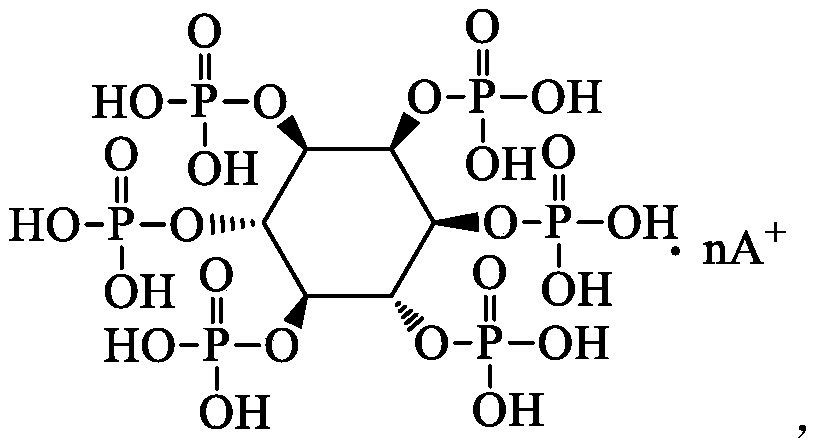Full-bio-based flame retardant, flame-retardant PLA composite material and preparation method thereof
A composite material and all-biological technology, applied in the field of design and synthesis of flame retardants, can solve the problems of non-environmental protection, large addition amount, low flame retardant efficiency, etc., and achieve the effect of cost reduction, low addition amount and excellent effect
- Summary
- Abstract
- Description
- Claims
- Application Information
AI Technical Summary
Problems solved by technology
Method used
Image
Examples
Embodiment 1
[0041] In a constant temperature water bath at 55°C, dissolve 37.7g of 70% phytic acid solution in 158.4mL of distilled water, and then slowly add ammonia water to adjust the pH to pH=4.5. Add it into the phytic acid solution and react for 5 hours; after the reaction, cool the reaction product to room temperature, add 600ml of ethanol to recrystallize and precipitate the reaction product, filter it with suction and dry it to obtain a full bio-based flame retardant with a yield of 76%. figure 1 It is an infrared comparison chart of the bio-based flame retardant prepared in Example 1 and raw materials phytic acid and sulfur-containing amino acid (taurine). From figure 1 It can be seen that the flame retardant contains all the characteristic peaks of phytic acid and taurine, while at 1490cm -1 A new characteristic peak appeared, belonging to -NH 3 + The stretching vibration peak of phytic acid and taurine can be proved that phytic acid and taurine have reacted successfully.
...
Embodiment 2
[0044] In a constant temperature water bath at 60°C, dissolve 37.7g of 70% phytic acid solution in 208.4mL of distilled water, then slowly add ammonia water to adjust the pH to pH = 3, and dissolve 57.6g of cystine in the aqueous solution, and slowly dissolve the cystine solution Add it into the phytic acid solution and react for 6 hours; after the reaction, cool the reaction product to room temperature, add 750ml of methanol to recrystallize and precipitate the reaction product, filter it with suction and dry it to obtain a full bio-based flame retardant with a yield of 69%.
[0045] 2.5g (5.0wt% addition) of the full bio-based flame retardant prepared in Example 2 and 47.5g of dried PLA were mixed uniformly and then put into an internal mixer for melting processing. The processing temperature was 170° C., and the time for 8min. The measured LOI of the composite material is 32.5, the vertical burning grade is FV-0 grade (3mm) grade, and the tensile strength is 59.2MPa.
Embodiment 3
[0047] In a constant temperature water bath at 65°C, dissolve 37.7g of 70% phytic acid solution in 258.4mL of distilled water, then slowly add ammonia water to adjust the pH to pH = 5, and at the same time dissolve 71.5g of methionine in the aqueous solution and then dissolve the methionine The solution was slowly added to the phytic acid solution, and reacted for 4.5 hours; after the reaction, the reaction product was cooled to room temperature, and 800ml of ethanol was added to recrystallize to obtain the reaction product, which was filtered and dried to obtain a full bio-based flame retardant with a yield of 78%.
[0048] 1.25g (2.5wt% addition) of the full bio-based flame retardant prepared in Example 3 and 48.75g of dried PLA were mixed uniformly and put into an internal mixer for melting and processing. The processing temperature was 160° C., and the time 10min. The measured LOI of the composite material is 30.5, the vertical burning grade is FV-0 grade (3mm) grade, and...
PUM
| Property | Measurement | Unit |
|---|---|---|
| Tensile strength | aaaaa | aaaaa |
| Tensile strength | aaaaa | aaaaa |
| Tensile strength | aaaaa | aaaaa |
Abstract
Description
Claims
Application Information
 Login to View More
Login to View More - R&D
- Intellectual Property
- Life Sciences
- Materials
- Tech Scout
- Unparalleled Data Quality
- Higher Quality Content
- 60% Fewer Hallucinations
Browse by: Latest US Patents, China's latest patents, Technical Efficacy Thesaurus, Application Domain, Technology Topic, Popular Technical Reports.
© 2025 PatSnap. All rights reserved.Legal|Privacy policy|Modern Slavery Act Transparency Statement|Sitemap|About US| Contact US: help@patsnap.com



